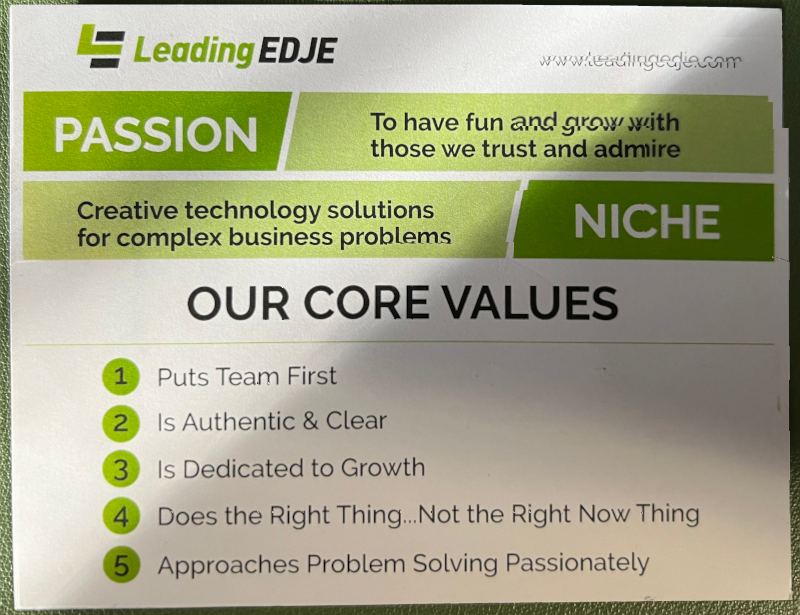Overview
I've been chatting with and mentoring people transitioning into tech, as well as those in tech that want to move somewhere else. I find myself saying the same things over and over again.
This article will cover things to account for, research, and practice:
- 30-second elevator pitch: Remember that it should go beyond the resume and LinkedIn.
- Company Website: People on LinkedIn, Products, Clients, Feedback, News, Articles, and Values.
- Posting: What is the job?
- Interviewer(s): LinkedIn, Posts, Articles.
- Stack: Tools, Libraries, Frameworks (anything on GitHub) - Release Notes and Related Projects.
- Company Sites: (i.e. Glassdoor) Interviews, About, People.
Plan out your questions. In particular, focus on tech stack and company core values.
The Concept
The basic idea is to put you more at ease at the beginning of your interview with the company itself.
30-Second Elevator-Pitch
I put this section first, because it's the interviewers first insight into you. It's important and can take some time.
Your pitch needs to answer the statement, "tell me about yourself."
The interviewer should already have read your resume and at least scanned your LinkedIn profile. Given that, you need to go beyond telling them what you did on a job.
What to write
- Who are you?
- Your unique value proposition.
- What are you looking for next?
- Why this conversation aligns with your "what's next?"
Bad Elevator-Pitch
At company XYZ I was a frontend developer. I created a search engine that helped the company increase sales by implementing a strong UI/UX. I also worked on a mobile application with text-to-voice in Ionic so that field technicians could enter data more efficiently.
This should all be on your resume, or at least in your LinkedIn profile.
Better Elevator-Pitch
I am a frontend developer that loves to write code and solve problems. I have strong communication skills that help me work well on teams. I enjoy working on teams that implement solid solutions that impact business needs.
Iterate over the pitch you are writing. Say it out loud. You might find yourself naturally using different words, or saying things in a different order.
And, remember that you can modify the elevator-pitch you create as you apply for different positions.
Elevator-Pitch Implementation
Practice, practice, practice ...
When you present, you need to showcase your excitement for this opportunity and your interest in their company.
The worst thing you can do is frown as you try to remember your pitch.
So, remember ... practice, practice, practice.
Company Website
The first part of what I recommend is generally not on the company's website, but LinkedIn.
LinkedIn Research
Research on LinkedIn to find out who is in the company. This is an important step. I've had people do this, only to find a relative or friend that's been working at the company all along. Having someone that can recommend you is extremely valuable.
General Details
Take the time to read about the company's products and clients. If there is client feedback, read about or listen to what they are saying. Many times on company sites, there is information about when they've been in the news. If there are articles, blogs, podcasts, or videos, spend some time reading, listening, and watching them.
Core Values
Always spend time researching a company's Core Values. This is a critical area - these values should align with your own to some degree.
You can also develop great questions in this area to answer the, "what do you want to know about us?" question.
Posting
What is the job?
Read the entire posting.
You don't want to miss some detail because you only scanned the posting. The version of some library or framework can radically change the preparation you do when looking at their tech stack.
Interviewer(s)
You should research the interviewer (or interviewers) on LinkedIn as well as searching for any posts or articles they have written.
The better you feel you know the interviewer, the more comfortable you will feel when speaking to them. This is a great way to reduce your stress.
Stack
The tech stack of the company is important. Knowing this and preparing will allow you to identify which domains of knowledge questions will come from.
Here, you want to identify any tools, libraries, and frameworks. The information might be on the job posting, it could be on other postings, it could be in public projects that the company has on GitHub.
Once you've identified the stack, look into the documentation of the key technologies used. Pay attention to things like change logs and release notes for a quick summary of what's changed over time.
Also, be smart about what I call related projects.
Examples: Angular projects often use RxJS. React projects often use some type of state management like Redux.
Spending some time looking at the documentation for these related projects will often help quite a bit.
Company Sites
Company sites like Glassdoor can provide additional information about interviews at a particular company.
Also realize that there's often information about the company and people that work there that's often not in other places.
Summary
The basic idea is to put you more at ease at the beginning of your interview with the company itself.
By preparing a solid 30-second elevator pitch, researching the company's website, actually reading the posting, researching the interviewer themselves, studying the tech stack they use, you can better position yourself when the times comes to interview.























